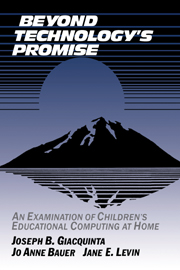Book contents
- Frontmatter
- Contents
- List of Tables and Figures
- Preface
- Chapter 1 THE PROMISE
- Chapter 2 STUDYING THE PROMISE
- Chapter 3 THE ABSENCE OF CHILDREN'S ACADEMIC COMPUTING AT HOME
- Chapter 4 THE AVAILABILITY OF EDUCATIONAL SOFTWARE
- Chapter 5 THE IMPORTANCE OF PARENTAL ENCOURAGEMENT AND ASSISTANCE
- Chapter 6 THE ROLE OF GENDER IN HOME COMPUTER USE
- Chapter 7 SCHOOL USE OF COMPUTERS
- Chapter 8 CHILDREN'S PREFERENCE FOR GAMES
- Chapter 9 REDEFINING A NEW TECHNOLOGY AS A SOCIAL INNOVATION
- Chapter 10 VIEWING TECHNOLOGICAL CHANGE AS A SOCIAL PROCESS
- Chapter 11 REEXAMINING THE HOME-SCHOOL COMPUTER CONNECTION
- Chapter 12 WHERE DO WE GO FROM HERE?
- Appendix A A FURTHER NOTE ON SITE FIELDWORK AND ANALYSIS
- Appendix B LIST OF CODES FOR SITE LOG ANALYSIS
- Appendix C SITE LOG ANALYSIS CODEBOOK
- Appendix D LIST OF FAMILIES AND SCHOOL-AGED CHILDREN
- Appendix E SPECIFIC STEPS FAMILIES MIGHT TAKE
- References
- Index
Chapter 2 - STUDYING THE PROMISE
Published online by Cambridge University Press: 05 March 2012
- Frontmatter
- Contents
- List of Tables and Figures
- Preface
- Chapter 1 THE PROMISE
- Chapter 2 STUDYING THE PROMISE
- Chapter 3 THE ABSENCE OF CHILDREN'S ACADEMIC COMPUTING AT HOME
- Chapter 4 THE AVAILABILITY OF EDUCATIONAL SOFTWARE
- Chapter 5 THE IMPORTANCE OF PARENTAL ENCOURAGEMENT AND ASSISTANCE
- Chapter 6 THE ROLE OF GENDER IN HOME COMPUTER USE
- Chapter 7 SCHOOL USE OF COMPUTERS
- Chapter 8 CHILDREN'S PREFERENCE FOR GAMES
- Chapter 9 REDEFINING A NEW TECHNOLOGY AS A SOCIAL INNOVATION
- Chapter 10 VIEWING TECHNOLOGICAL CHANGE AS A SOCIAL PROCESS
- Chapter 11 REEXAMINING THE HOME-SCHOOL COMPUTER CONNECTION
- Chapter 12 WHERE DO WE GO FROM HERE?
- Appendix A A FURTHER NOTE ON SITE FIELDWORK AND ANALYSIS
- Appendix B LIST OF CODES FOR SITE LOG ANALYSIS
- Appendix C SITE LOG ANALYSIS CODEBOOK
- Appendix D LIST OF FAMILIES AND SCHOOL-AGED CHILDREN
- Appendix E SPECIFIC STEPS FAMILIES MIGHT TAKE
- References
- Index
Summary
Qualitative methods can be used to uncover and understand what lies behind any phenomenon about which little is yet known. It can be used to gain novel and fresh starts on things about which quite a bit is already known. Also, qualitative methods can give the intricate details of phenomena that are difficult to convey with quantitative methods.
(Strauss and Corbin, 1990, p. 19)Educational and social science investigations are broadly classified as either qualitative or quantitative in form. In the first part of this chapter, we discuss the decision to study family computing qualitatively. Then, we review some of the study's more salient fieldwork activities and log-analysis procedures. In the final section, we compare the seventy families studied. To simplify the discussion, the words “we” and “our” are used throughout the book, even though Bauer and Levin were not involved in the early SITE decision making and fieldwork.
PRIOR RESEARCH ON EDUCATIONAL HOME COMPUTING
At the time the SITE study was designed, information about children's educational computing at home was largely found in articles in the popular press and in computer magazines. These articles were based on market researchers’ quantitative surveys about computer hardware and software and on reporters’ qualitative portrayals of families. Both approaches to gaining information about educational computing at home, however, contained serious flaws.
The measurement and sampling methods of the early market surveys left their findings suspect. The assessment of educational computing in families was usually peripheral to the main purpose) of these marketing surveys, and respondents were simply asked to indicate whether their computers were being used for educational purposes or whether they had specific types of educational software.
- Type
- Chapter
- Information
- Beyond Technology's PromiseAn Examination of Children's Educational Computing at Home, pp. 13 - 29Publisher: Cambridge University PressPrint publication year: 1994

